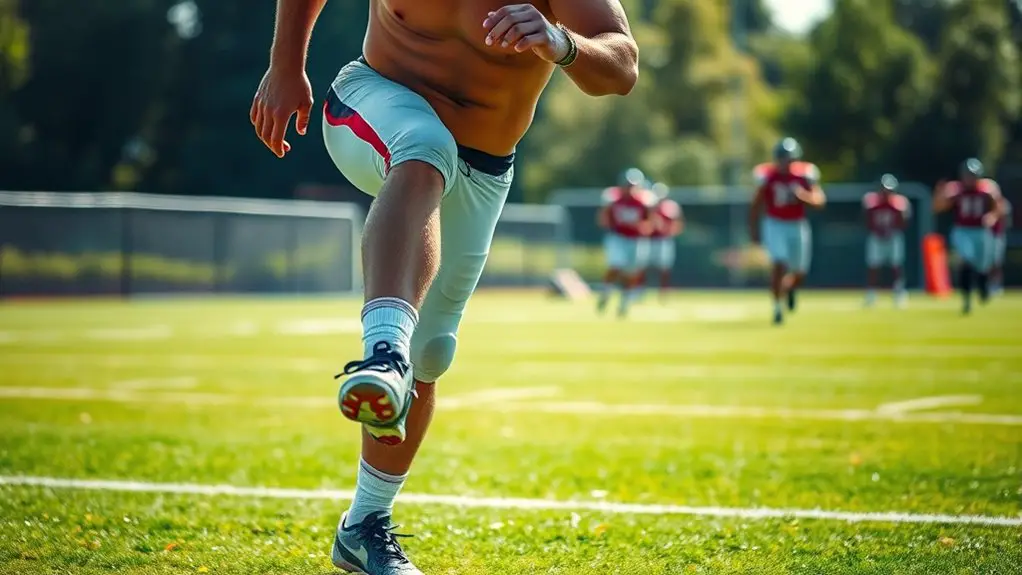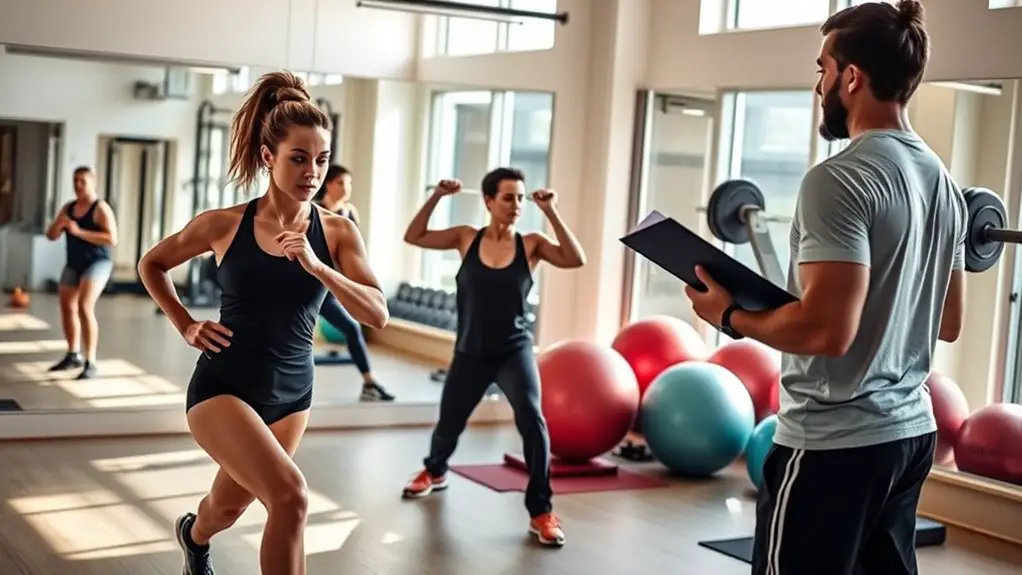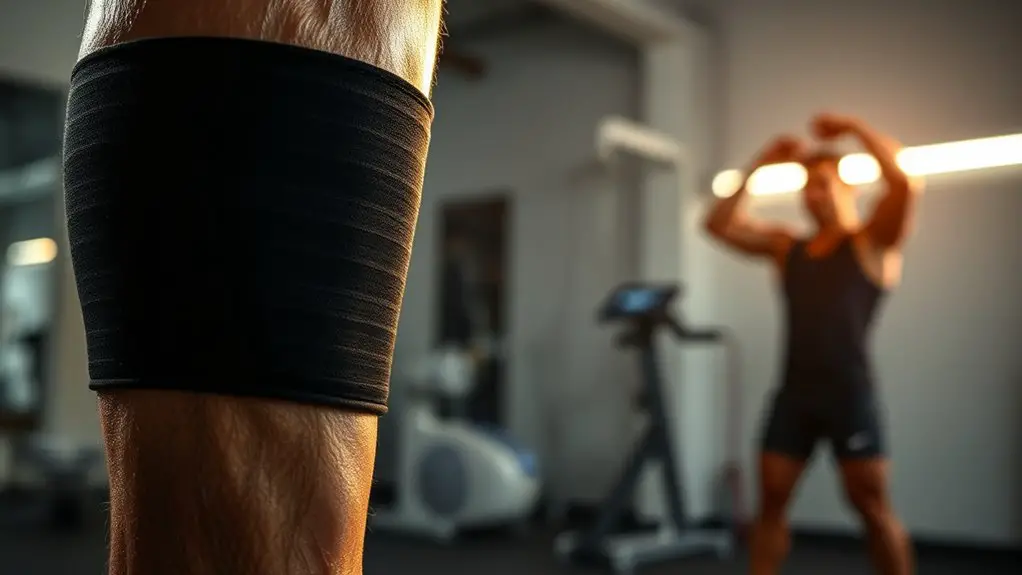Hip mobility is key for football players because it enhances your agility, speed, and overall performance on the field. When your hips are flexible, you can change directions quickly, improve your stride length, and execute powerful kicks and tackles. Limited hip mobility can lead to injuries and restrict your effectiveness. By focusing on mobility training, you can reveal your full athletic potential. Discover how to integrate these practices into your training routine for even better results.
The Importance of Hip Mobility in Football
When you think about football performance, it's easy to overlook the importance of hip mobility, yet it plays an essential role in your overall effectiveness on the field. Your hips are central to hip function, allowing for explosive movements like sprinting, cutting, and tackling. When your hip mobility is limited, you restrict your athletic performance, reducing agility and speed.
Imagine the freedom of moving fluidly, executing sharp turns, and maintaining balance, all thanks to well-functioning hips. Improved hip mobility enhances your range of motion, enabling you to respond quickly to dynamic plays and evade defenders. Incorporating mobility training into your routine can significantly improve your hip flexibility and overall athletic performance.
You'll notice a significant difference in your gameplay when your hips are loose and flexible. This not only contributes to better performance but also helps prevent injuries. So, prioritize hip mobility in your training regimen to release your full potential on the field. Embrace the freedom that comes with superior hip function!
Benefits of Improved Hip Flexibility
Improved hip flexibility can make a world of difference for football players. When you enhance your hip flexibility, you reveal a range of hip flexibility benefits that can elevate your game. You'll notice better agility, allowing you to change direction quickly and evade defenders with ease. This mobility not only boosts your performance but also reduces the risk of injuries, keeping you on the field longer.
With greater hip flexibility, your stride length increases, translating to faster sprints and improved acceleration. You'll also experience more powerful kicks and tackles, thanks to the added range of motion. These performance enhancements can set you apart from your competition, giving you the freedom to play at your best. Remember, it's about more than just the game; it's about enjoying the freedom to move fluidly and confidently. By prioritizing hip flexibility, you're investing in your athletic journey and overall game performance. Additionally, incorporating proper warm-up routines can further enhance your hip flexibility and overall readiness for the game.
Common Hip Mobility Issues in Athletes
You might not realize it, but many athletes struggle with limited range of motion due to tight hip flexors. This can hinder your performance on the field and increase the risk of injury. Identifying these common hip mobility issues is essential for maintaining ideal athletic function. Improved flexibility allows athletes to move more efficiently and adapt to the demands of the game.
Limited Range of Motion
Although hip mobility is essential for ideal athletic performance, many football players struggle with a limited range of motion due to various factors. You might find that limited flexibility in your hips can hinder your speed, agility, and overall effectiveness on the field. Mobility assessments can help pinpoint specific issues, revealing restrictions that may be holding you back. Whether it's from tight muscles, previous injuries, or lack of proper warm-up routines, these limitations can impact your game. Embracing targeted flexibility exercises and mobility drills can help you regain that freedom of movement. Don't let restricted hips keep you from reaching your full potential. Take the time to address these issues, and watch your performance soar.
Tight Hip Flexors
Limited range of motion often leads to tight hip flexors, a common issue faced by many athletes, including football players. When your hip flexors are tight, you might struggle with explosive movements, limiting your athletic performance on the field. This restriction can hinder your speed, agility, and overall effectiveness in plays, making it tough to reach your full potential. You might find yourself feeling tightness or discomfort, which can affect your game and increase the risk of injuries. To gain freedom in your movements, it's essential to prioritize hip mobility exercises. Stretching and strengthening your hip flexors can help you regain that important range of motion, ultimately enhancing your performance and allowing you to play without constraints.
Exercises to Enhance Hip Mobility
To improve your hip mobility, incorporating specific exercises into your routine is key. You'll want to focus on dynamic warm-up techniques, effective stretching routines, and strengthening exercises that can enhance your overall performance. Let's explore how these elements can make a real difference in your game.
Dynamic Warm-Up Techniques
When you're gearing up for a football session, incorporating dynamic warm-up techniques is essential for enhancing hip mobility. These exercises not only prepare your body for action but also improve performance and reduce injury risk. Here are some effective mobility drills to contemplate:
| Exercise | Purpose |
|---|---|
| Leg Swings | Loosens hip flexors |
| Walking Lunges | Engages glutes and quads |
| High Knees | Increases hip and leg mobility |
| Toy Soldiers | Stretches hamstrings dynamically |
Stretching Routines Overview
While dynamic warm-ups are essential, incorporating dedicated stretching routines can greatly enhance your hip mobility. You'll want to focus on both static stretching and foam rolling to release your hips. Start with foam rolling to release tight muscles and improve blood flow. Spend a few minutes rolling out your glutes, quads, and hip flexors—this'll help you feel freer. After foam rolling, plunge into static stretching. Target key areas like the hip flexors, hamstrings, and glutes with stretches like the pigeon pose and butterfly stretch. Hold each stretch for at least 30 seconds to maximize flexibility. By committing to these routines, you'll not only improve your hip mobility but also enhance your overall performance on the field. Freedom in movement starts here!
Strengthening Exercises Benefits
Strengthening your hip muscles isn't just about building power; it considerably enhances your mobility on the field, too. Through targeted strength training, you'll improve your range of motion, allowing for more agile movements. This freedom of movement translates directly into performance enhancement during games. Stronger hips help you change direction quickly, accelerate faster, and maintain balance, giving you an edge over opponents. Incorporating exercises like squats, lunges, and hip bridges into your routine will not only fortify your hip muscles but also promote overall stability. When your hips are strong and flexible, you'll feel more confident and capable on the field. Embrace these exercises to release your true potential and take your game to the next level!
Integrating Hip Mobility Training Into Practice
Integrating hip mobility training into practice is essential for football players looking to enhance their performance and reduce injury risk. By weaving hip mobility drills into your regular training sessions, you can release greater movement freedom on the field. Start by dedicating a portion of your warm-up to dynamic stretches that target the hips, like leg swings and hip circles.
During practice integration, consider incorporating partner drills that emphasize hip mobility, like resistance band walks or lateral lunges. These activities not only improve mobility but also foster teamwork and camaraderie. Additionally, enhancing agility and coordination can significantly improve your overall performance on the field.
Don't forget to cool down with static hip stretches post-practice, allowing your muscles to recover and adapt. By consistently working on hip mobility, you'll notice improvements in your agility, speed, and overall athleticism. Embrace these practices, and you'll empower yourself to perform at your best while enjoying the freedom of movement that comes with enhanced hip mobility.
The Impact of Hip Mobility on Injury Prevention
As you focus on enhancing your hip mobility, you'll find that it plays an essential role in preventing injuries on the field. Improved hip mobility allows for better range of motion and stability, reducing strain on other areas of your body. This is vital, especially when you consider injury statistics that show how often hip-related issues sideline players. By actively working on your mobility, you're not just improving your performance; you're also laying the groundwork for a longer, injury-free career. Incorporating effective rehabilitation strategies into your training can further strengthen your hips. Exercises that target flexibility, strength, and stability can help you bounce back faster and reduce the risk of recurring injuries. Additionally, focusing on proper warm-up techniques can significantly enhance your mobility and reduce injury risk. By prioritizing hip mobility, you're investing in your body's freedom to move fluidly and perform at its best, keeping you in the game and off the sidelines.
Frequently Asked Questions
How Does Hip Mobility Affect Overall Athletic Performance?
Hip mobility plays an essential role in your overall athletic performance. When you've got good hip flexibility, you can move more freely, enhancing your athletic agility. This freedom allows you to change direction quickly, sprint faster, and execute powerful movements with ease. Tight hips can limit your range of motion, making you feel restricted and affecting your performance. So, improving your hip mobility can release your potential and elevate your game to new heights.
Can Poor Hip Mobility Lead to Chronic Pain?
Yes, poor hip mobility can definitely lead to chronic pain. When your hips aren't moving freely, it puts extra stress on your joints and muscles, increasing the risk of chronic injuries. You might find yourself struggling with pain management as daily activities become more challenging. Improving your hip mobility can help you regain freedom of movement and reduce the likelihood of these issues, allowing you to enjoy a more active, pain-free lifestyle.
What Age Should Players Start Hip Mobility Training?
Ever wonder when's the right time to plunge into hip mobility training? It's essential to start early, ideally during youth training, when flexibility development is at its peak. By introducing these exercises in your pre-teen years, you're setting the stage for a more agile future. Don't wait until you're feeling stiff or restricted; start now to enjoy the freedom of movement on the field. Your hips will thank you later!
How Often Should Football Players Train Hip Mobility?
To maximize your performance, you should integrate hip mobility routines into your training frequency at least three times a week. This consistency helps maintain flexibility and strength. You don't have to spend hours; just 15-30 minutes per session can make a significant difference. Listen to your body and adjust as needed, ensuring you feel loose and free during your movements. Remember, it's all about enhancing your game while enjoying the process!
Are There Specific Warm-Ups for Hip Mobility Before Games?
You might not realize it, but the right warm-ups can release your potential before a game. Think dynamic stretches and mobility drills that really get your blood pumping. Try leg swings, hip circles, and lunges to prepare those essential joints. It's all about freedom of movement, letting you dance past defenders with ease. Don't skip these important steps; your performance could hinge on how well you've prepped your hips beforehand.




